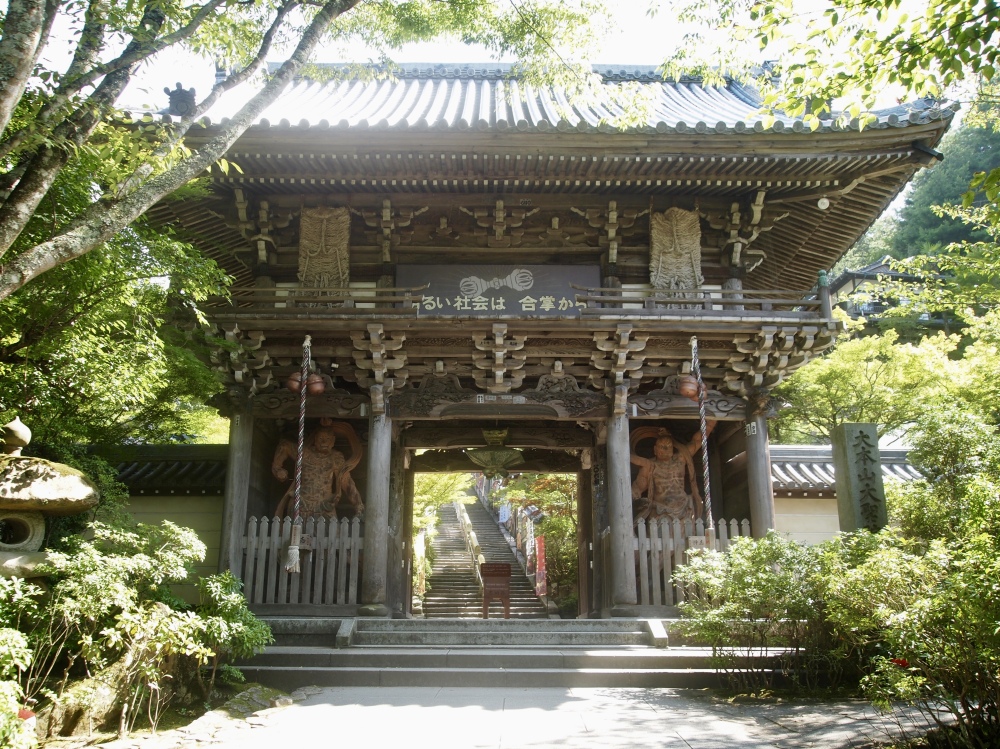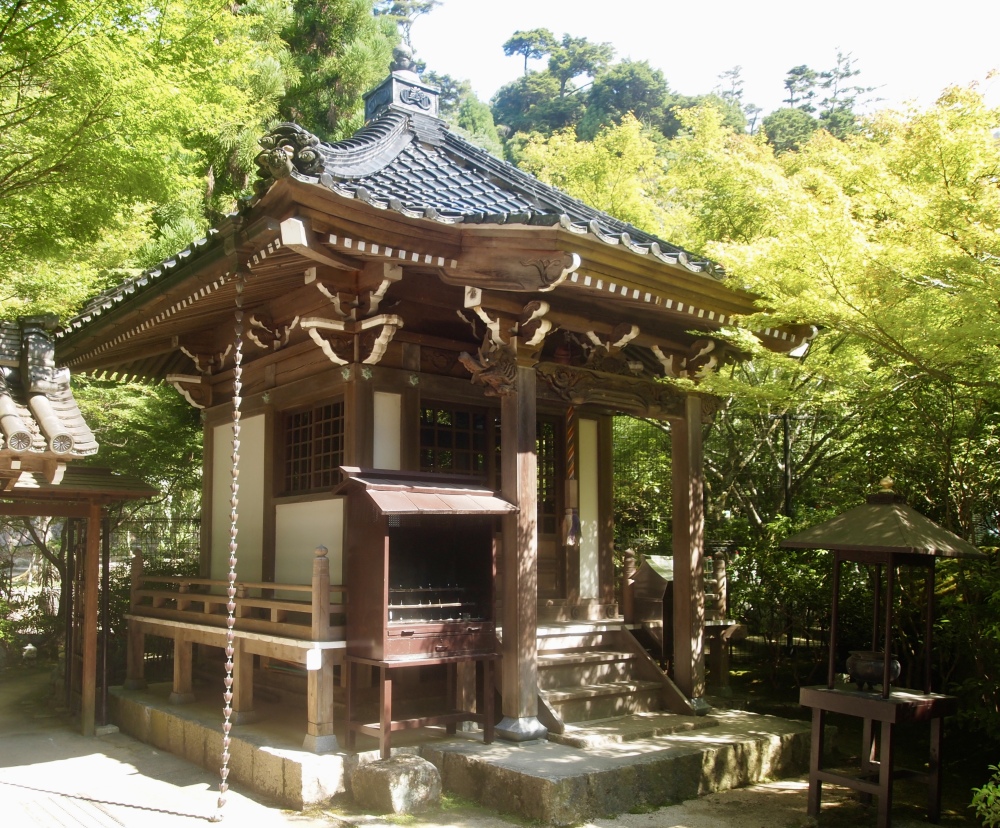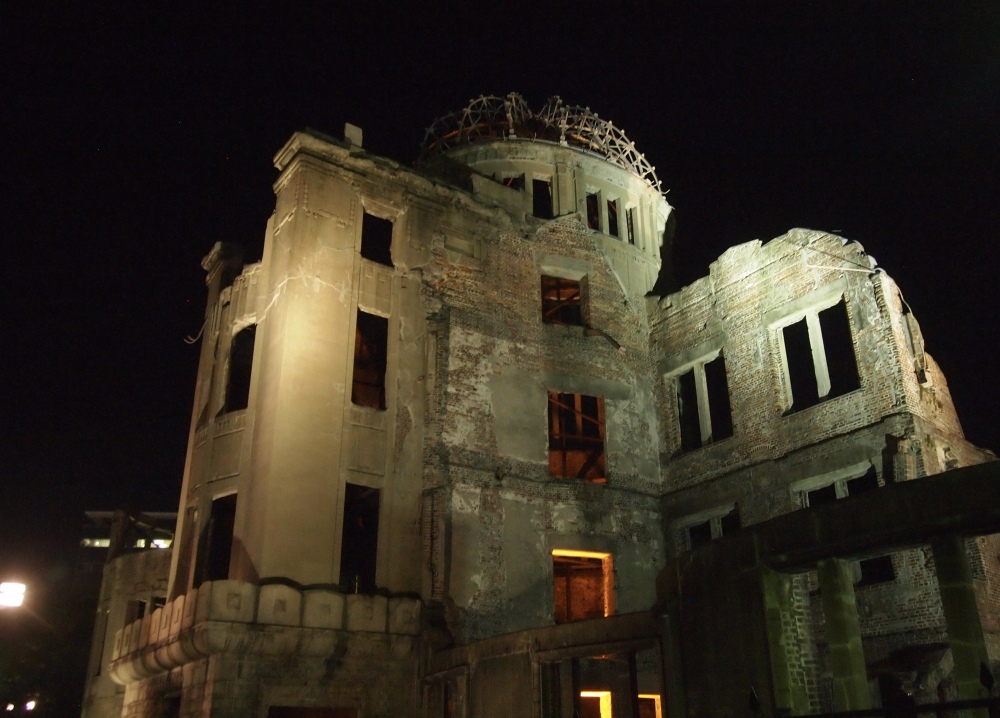Wednesday, August 2: After visiting the O-torii Gate at Itsukushima Shinto Shrine at somewhat low tide, I take a break to walk uphill toward Daishō-in, a historic Japanese temple complex on Mount Misen, the holy mountain on Miyajima. Including Mt. Misen, Daishō-in is within the World Heritage area of Itsukushima Shrine.
Mt. Misen sits in the middle of Miyajima Island. The mountain was opened as an ascetic holy mountain site by Kobo Daishi in the autumn of 806 when he underwent ascetic practice for 100 days in the mountain. The fire lit by Kobo Daishi is said to have been burning for 1200 years. The fire was used to light the Flame of Peace in the Hiroshima Peace Memorial Park.
Daishō-in Temple is one of the most prestigious Shingon Temples in the western part of Japan. The Shingon, or “True Word,” branch of esoteric Buddhism, was introduced to Japan from China in the 9th century. Shingon involves trying to reach the eternal wisdom of the Buddha that wasn’t expressed in his public teaching. The sect believes that this wisdom may be realized through rituals using body, speech, and mind, such as the use of symbolic gestures (mudras), mystical syllables (dharani), and mental concentration (yoga). The whole is intended to arouse a sense of the pervading spiritual presence of the Buddha that resides in all living things, according to Encyclopedia Britannica: Shingon.
In the 12th century, Emperor Toba founded his prayer hall in Daishō-in. The temple had close links with the Imperial Family until the 19th century. Emperor Meiji stayed in the temple in 1885 (Welcome to Miyajima: Daishō-in).
Though I love the bright vermilion of many Japanese temples, I have a fondness for the wooden structures that look ancient and weathered and seem to blend in with nature.
The Niomon Gate serves as the official gateway into the temple. A pair of guardian king statues stand by the gate. Nio kings are believed to ward off evil, and are determined to preserve Buddhist philosophy on earth.

Niomon Gate of Daishō-in
Kukai, posthumously known as Kobo Daishi, is the founder of the Shingon sect. In 804, at age 31, he went to Tang, China, where he mastered profound esoteric teachings. He is also well-known as one of the three greatest calligraphers in Japan.

Niomon Gate

lantern at Daishō-in
Lining the steps to the temple are the statues of 500 Rakan statues. These represent Shaka Nyorai’s disciples. These images all have unique facial expressions. Besides the Rakan statues listed on the map below, there are other statues spread sporadically throughout the temple complex.

map of Rakan statues at Daishō-in
There are so many interesting things to see at this temple complex, even if I don’t know what many of them are.

water pavilion at Daishō-in

Daishō-in

Shimo Daishi-do Hall at Daishō-in
Along the temple steps is a row of spinning metal wheels that are inscribed with sutra (Buddhist scriptures). Turning the inscriptions as one walks up is believed to have the same effect as reading them. So, without any knowledge of Japanese, a visitor can be blessed with enormous fortune by turning the wheels (japan-guide.com: Daishō-in).

stairs and prayer wheels
The bell in the belfry was once rung to tell the time in the morning, afternoon and evening in the past. Now it is rung to start the time for worship.

Belfry
Kannon-do Hall was established to enshrine the image of Kannon Bosatsu, the Deity of Mercy.

Kannon-do Hall
A mandala using colored sand depicts the divine figure of Kannon Bosatsu, the symbol of mercy. The mandala was made by Buddhist priests from Tibet.

Kannon-do Hall
Bosatsu, or Bodhisattvas, are the ones who are undergoing ascetic training to attain enlightenment; they are committed to NOT becoming Nyorai (the highest deities of Buddhism who have attained enlightenment) unless all sufferers on earth are saved. To show their determination, Bosatsu images hold various objects.

Kannon-do Hall
Maniden Hall is the main prayer hall where Sanki Daigongen, or the Three Awesome Deities of Mt. Misen, are enshrined.

steps to Maniden Hall
Worshipers pray at Maniden Hall for good health, longevity, and contentment in their daily lives.

Maniden Hall
Commemorating the current (77th) head priest’s succession, 1,000 Fudo myo-o, or Immovable King, images were donated by worshipers.

one thousand Fudo myo-o, or Immovable King, images

figures at Daishō-in
In the dimly lit Henjokutsu Cave are the sand and the principal Buddhist icons of the 88 temples of the prestigious pilgrimage route on Shikoku. Worshipers believe that they are given the same blessings as people who make the pilgrimage to all the temples on the route (Welcome to Miyajima: Daishō-in).
It is my dream to one day do the Pilgrimage to the 88 Sacred Places of Shikoku.

representations of 88 temples of Shikoku in Henjokutsu Cave

pond at Daishō-in

figure at Daishō-in
After leaving Daishō-in, I visit Itsukushima Shinto Shrine and the O-torii Gate once again, as I make my way back to the ferry. This time the tide is higher (miyajima: itsukushima-jinja & the floating o-torii gate). Then I return by ferry and train to Hiroshima. At my hotel, I ask for a recommendation for a good okonomiyaki restaurant. Hiroshima is famous for oysters and okonomiyaki (savory pancakes: batter, cabbage, vegetables and seafood or meat cooked on a griddle). The local version, Hiroshima-yaki, features individual layers, and noodles as the key ingredient (Lonely Planet Japan).
The place recommended by the hotel is open air with no air-conditioning. It is much too hot for me to eat in there. I’ve been sweating all day and look forward to cooling off during dinner. So I walk back up the same street and find the perfect (air-conditioned) restaurant.

diner for Hiroshima-yaki
Here I’m greeted by a very friendly waitress who speaks some English. A baseball game is on the TV in the background, and she keeps cheering for the Hiroshima Toyo Carp, the local baseball team.

diner for Hiroshima-yaki
It’s quite a process watching the chef whip up the Hiroshima-yaki. I’m able to order mine with just shrimp. I never want squid in these pancakes, even though squid seems to be the most common ingredient.
I have to say this pancake is one of the most delectable things I’ve eaten in Japan. Even though it’s huge, and filling, I have to eat every last bite. 🙂
After dinner, I stroll along the river in Hiroshima.
I see one last view of the Hiroshima A-bomb dome.

Hiroshima A-bomb dome

Hiroshima A-bomb dome

paper cranes for peace
Tomorrow morning, I’ll leave for Nara, where I’ll spend two nights. 🙂
Total steps today: 21,442 (9.09 miles)
















































